EPISODE 6: Jan 23
ซีรีส์ที่ถูกเก็บถาวร ("ฟีดที่ไม่ได้ใช้งาน" status)
When?
This feed was archived on October 01, 2021 08:11 (
Why? ฟีดที่ไม่ได้ใช้งาน status. เซิร์ฟเวอร์ของเราไม่สามารถดึงฟีดพอดคาสท์ที่ใช้งานได้สักระยะหนึ่ง
What now? You might be able to find a more up-to-date version using the search function. This series will no longer be checked for updates. If you believe this to be in error, please check if the publisher's feed link below is valid and contact support to request the feed be restored or if you have any other concerns about this.
Manage episode 273142424 series 2781331
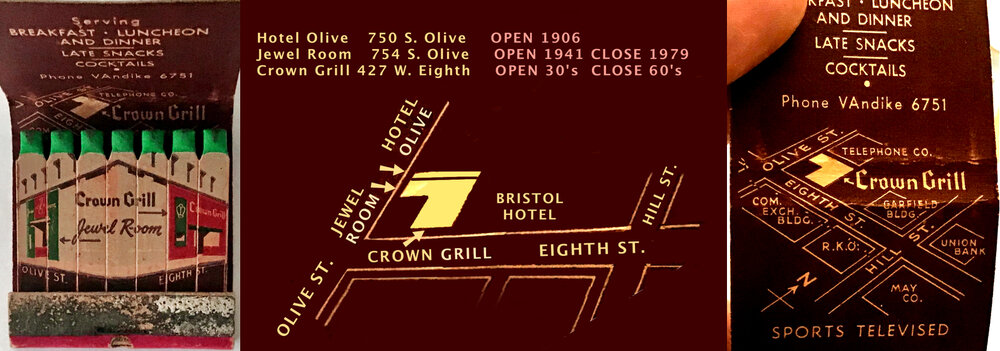
The Crown Grill & Jewel Room were separate businesses with same ownership in 1947. Hotel Olive occupied the 2nd & 3rd floor of building and had significant symbiotic relationships with the Jewel Room & the Crown Grill. In center image I embellish the matchbook map to show the Hotel Olive.
Welcome to the The Black Dahlia and the Blue Dahlia podcast episode 6. I am your host Scott Tracy.
The police have located Lynn Martin, an ex-roommate who had lived with Beth Short in Hollywood and who disappeared at the same time as Beth.
The discovery of Miss Martin climaxed a backtracking by 1,000 officers of the gay path cut through Hollywood and Los Angeles night life by "the Dahlia.” Det. Lt. William Cummings, who traced Miss Martin to the valley auto court, said she has a record of eight arrests on juvenile charges in Long Beach. The girl, who appears to be in her early 20's, will be 16 next Saturday. She broke her stoic resistance to investigators' continuous questioning when Cummings began asking her about the scars... Through acquaintances of the girl the detective had learned that her upper body was scarred by the removal of tattooing, he said. When confronted by the detective's apparent intimate knowledge of her past, Miss Martin was quoted as blurting, "Oh, what's the use of trying to hide anything from you!" She then admitted her juvenile record and other more recent associations. Investigation had traced Miss Martin to a motel on Ventura Blvd., where she was seen as late as midnight Jan. 14, the night before Miss Short's severed body was found in a vacant lot near busy Crenshaw Blvd.*
The police hoped for a useful lead from Lynn Martin. Of course she wasn't hiding because she was involved in the crime, Lynn is only guilty of being underage. Lynn has not been in contact with Beth for many weeks. Certain witness are sure they saw Beth Short in the days prior to her death. Many of the observations from strangers turn out to be false leads; the baggage handler that sees Red with a black haired woman who asks about Alaska, turns out to be wrong. A Greyhound bus driver mistakenly believed Beth was on his route from Santa Barbara to downtown Los Angeles on January 14th.
Elizabeth Short’s appearance is striking and uncommon; there is no such thing as a Goth look in 1947. The heavy make-up resonates with an identity one would associate with a silent film star or geisha girl; neither of these is a foundation for a movie career, but it makes a dramatic impression. The newspapers describe her contrasting appearance of black hair and pale skin, however if you think about it, that description would fit Elvira as well as Dita Von Tease.
I believe the witnesses who knew Elizabeth Short when they speak of seeing her during the lost days and tend to be dismissive of strangers who think they saw Elizabeth, with one very important exception. Myrl McBride, a policewoman.
A Police bulletin is issued in the 21st of January seeking witness who would assist the investigation WANTED INFORMATION WHEREABOUTS OF ELIZABETH SHORT Between January 9th and 15th 1947.Description female American 22 years 5‘6“ 118 pounds black hair green eyes very attractive bad lower teeth fingernails chewed to the quick this subject was found brutally murdered body severed and mutilated January 15, 1947 at 39th and Norton Ave. Subject on whom information wanted was last seen January 9, 1947 when she got out of the car at Biltmore Hotel ... Subject makes friends with both sexes and frequented cocktail bars and night spots. Note the police seek information starting with her arrival at the Biltmore. Of course Beth was seen leaving the hotel, they clearly hope for more Biltmore witnesses. Elizabeth Short is not reported missing on the evening of the 9th or 10th or 11th 12th or 13th or 14th. The police have witnesses who have seen her, but have no knowledge where she spends the night. As I have noted previously, where is she missing from? She doesn’t live anywhere so who would report her missing? Anne Toth thinks she’s in Berkeley, Joseph Fickling believes she’s on the way to Chicago, Phoebe Short thinks she working at a naval hospital in San Diego, Mark Hansen declined to allow her to return to his house and Lynn Martin hasn’t seen or spoken to her for over two months. Beth is HOMELESS. There are only two options for these seven days. She been abducted and all the witnesses are wrong. Or she has been depending on the kindness of strangers as she did in San Diego and she is sleeping on couches until her luck runs out? THE local newspapers tell a story as a Hollywood tragedy of abduction and torture. The out of town papers tell a story of a squandered life tossed aside like a cigarette. In another decade, Beth might have been a beatnik or a hippie. She is only 22 years old. but has seen more of America than most 22 year olds. Emotionally she still a teenager, infatuated with different men on different nights. A day dreamer and freeloader, not much of a doer. Age-wise, emotionally, I would say Lynn Martin is the 22 year old and Beth Short is the 15 year old.
The police bulletin states Beth is friendly, in fact, she has few friends. It becomes frustrating for the police to find so many that recognize Beth but do not know her at all. Her drunken father abandoned her twice. Beth seems to carry that betrayal within her, along with the idea that the world owes her; folks do feel sorry for her and try to help. Oddly, she isn’t as thankful as these Good Samaritans might expect. Beth is narcissistic but not malicious, she lies easily and often. I was bothered quite a bit when I first started to research the crime about this pattern of dishonesty, and now I think of it as situational. Sometimes Beth lies when she first meets someone, to add depth to her story she gives herself a past; she was married she had a baby and lost it; sometimes she gives herself a future as a movie extra or model going to Chicago. Beth simply is inventing a more interesting version of herself to present to others. Sometimes she introduces herself as Beth, other times Bettie or Elizabeth; is one name better than another? Beth is trying them out. When police interviewed acquaintances they find a trail of disappointed men and disapproving women.
Since police think criminals lie; in the eyes of a police detectives like Hansen and Brown, her actions are those of a grifter. Beth has no job, how does the rent get paid? Why is she hanging around in bars like a freelance “B” girl, Hansen sees a young woman with the game plan of a carny. Hansen realizes Beth’s dating game is rigged sideshow. No kewpie doll for you, sailor but thanks for picking up the tab. As of this date, the current police thinking was that Beth would date men for free meals and save her passion for women.
January 22nd 1947 Bakersfield Californian QUOTE "It sounds like a cheap detective thriller," said Capt. Donohoe of the homicide squad, "but we finally were forced to turn to the theory that a woman was at the bottom of it." (Donohoe) pointed to other mutilation murders in which women in jealous rages hacked their girl friends to death.**
The sighting of Beth during these 7 days that strikes me as the most solid is the commentary of bartender Buddy La Gore, who told of observing Beth Short with two brunettes. “Always fastidious and proud of her apparel, she appeared disheveled and ‘frantic-eyed’ that night, La Gore said. "She, looked as, if she had slept in her clothes for days. Her black sheer dress was stained and crumpled. "She always wore the best nylons. but this time she had no stockings on.”
I have to believe a bartender that notices nylons.
Continuing, “her hair was straggly. Lipstick had been smeared on at a hit-or-miss angle. The powder on her face was caked. Another thing I noticed, she was cowed, instead of being gay and excited, the way I'd always seen,… Also, she was friendly and nice to me instead of acting like a 'grand lady' and bossy. La Gore said Miss Short and the two brunettes sat at a corner table whispering as they sipped beer. They left after an hour.”
More News of a sighting; a red-haired man entered the Gay Way Bar on 514 South Main Street on the night of January 12th and asked dancer, Betty Blake for Beth, Betty knew Beth had been in that bar earlier that night. † The Jewel Room and the Gay Way Bar were among the downtown locations that were rumored to cater to a homosexual crowd. During the war years, the military posted signs at every place they suspected drew a gay crowd, that said “Out of bounds to military personnel.” With the war over, a new sign is posted next to the door at the Gay Way Bar— SERVICEMEN WELCOME. Betty Burke says she saw Beth sitting alone in the bar earlier that night. but did not say so to the red haired man. ††
Homosexuality is classified as mental illness at this time.§ The public strongly associates homosexual behavior with pedophilia.§§ Dr. deRiver, the LAPD’s criminal psychiatrist considered homosexuals to be QUOTE “a grave danger to society” and “seducers of children.” In “sexual orgies,” DeRiver added, “they were even prone to commit murder.” A baseless and idiotic claim. DeRiver has a list of 10,000 sexual deviants.
The Jewel Room has an important role to play during the seven missing days, but there is a fair amount of confusion. The LAPD struggles to find willing witnesses. And when the Crown Grill witnesses supply information, it is sometimes contradictory. One witness will say they saw Beth and another worker will say she was not there that night. Leaving the testimonies at odds and open to interpretation.
If we go to various web sites, you’ll notice a variance of opinion. Larry Harnish QUOTE The Crown Jewel Cocktail Room (also known as the the Crown Jewel Grill, the Crown Grill and the Crown Grill Cocktail Lounge), 427 W. 8th St., was just another downtown bar where people thought they had seen Elizabeth Short. There is a shadow — but only a shadow — of truth because her roommate Ann Toth sometimes met her boyfriend there.
What Ann Toth says in her testimony to the investigators. Beth “may have gone down there because of my going down there with Leo, but I never saw her there… Leo Hymes was more of a regular and gave the first names of three bartenders at the Crown Grill.‡
The Deranged crimes web site accepts the possibility of Beth going there. QUOTE She may have been headed for the Crown Grill at Eighth and Olive. She’d been there before and perhaps she hoped to bump into someone she knew; after all, she needed a place to stay.
When asked if they’d seen Beth, most of the patrons were reluctant to talk to the police. By day the bar catered to the lunch crowd, lots of men escorting women who were not their wives. By night the clientele was mostly gay men. Because homosexuality was illegal there were only a few places where men could meet.”
Police Investigators were aware of the reputation of the bar and spoke Anne Toth about Beth’s attitude toward lesbians, asking, Didn’t she "indicate to you she wasn't fond of queer women?” Ann replied, "No, she always made the statement, very queer people in this town, queer people, referring to both men and women I guess. That is the only thing referring to queers that she ever mentioned … Why did (Beth) go through the trouble of wearing falsies and all that, to attract a queer lesbian, because either they go for you or don't go for you, they don't care if you haven't any shape. As far as that goes, in my estimation, I think she was definitely out to attract men. I can't see anyway of her wanting to attract a woman, because I would definitely notice it. I have been around enough to notice it in this town -- I would notice it.”
Wikipedia QUOTE Beth was allegedly seen by patrons of the Crown Grill Cocktail Lounge at 754 South Olive Street
In the District Atty files QUOTE “Elizabeth Short and her friend Marjorie Graham and Ann Toth were known drinking customers of this bar.” ‡‡
Chris Anaya, a waitress that started working at the Crown Grill after the death of Elizabeth Short, told District Atty investigator James F. McGrath that she heard from fellow employees that Beth was a customer. She was seen in the company of a "beautiful redhead," a waitress named Kay Graham, and a blonde girl called June Pina, McGrath said.
Anaya also said she heard that the three of them "spent several nights at a hotel situated just above this cocktail bar known as the Olive Hotel."
At the time of the grand jury investigation, the hotel records did not indicate a room had been occupied by any of the three women; however, McGrath stated the records were in poor condition and further checking was scheduled.” Note that Anaya is a hearsay witness. Police certainly struggle with getting straight answers. The night bartender at the Crown Grill on January 9th was Joe Scalise, who seemed to have issues with women who declined his advances. Hitting on women should never lead to hitting women. Scalise was a suspect at one point. Question of the day, “What is a raging heterosexual bartender with anger management issues doing working in a gay bar?” One more confusing Crown Grill bit of testimony. Another relevant file from the DA office states; Francis Campbell, is said to be bi-sexual by her associates at the Crown Grill Bar, waitress Bernice Smith, and waitress Marjorie Underorbok. They all knew victim as a customer of this bar two blocks from the Biltmore Hotel. Suspect, Campbell, stated she was on duty the night of victim’s disappearance. A few days after the murder, Officer Ed Barrett was told by a bartender in the Crown Grill that victim was in there that night alone. Suspect Francis Campbell never came forth with (this) information….
What are we to make this place with three names and two addresses? And a wildly different clientele base day and night? Very Jekyll and Hyde. This question is a Gordian knot in the investigation. I sliced thru this knot with a matchbook I bought on eBay.
Inside the Crown Grill matchbook cover is a neighborhood map that shows that the Crown Grill is at 429 W 8th and the Jewel Room is at 754 S Olive. The matchbook advertises the Crown Grill serves breakfast, luncheon, dinner, late snacks and cocktails. There is no such place as the Crown Jewel Grill or the Crown Grill Cocktail Room. The Jewel Room and the Crown Grill were separate businesses and had separate liquor licenses. Picture on the matchbook cover is on the website.
The Olive Hotel was the primary tenant at the corner of Olive and 8th Street in 1947, operating the two floors of rooms above. A guest would enter the small lobby on the ground floor and check in with the clerk then go upstairs to the rooms. Or eat or drink on the first floor. The Hotel Olive opened as the Rockwell in 1906. The Crown Grill opened in the 30’s and changed its name to Lou Silver’s Crown Grill in 1956 and closed in the 60’s. The Jewel Room opened in 1941 and closed its doors in 1979. Hotel Olive address 750 S Olive. The Jewel Cocktail Room entrance was at 754 S. Olive Street. The Crown Grill benefited the Hotel Olive as an onsite restaurant. The Jewel Room benefited the Hotel Olive by offering a potential stream of cash clients who might need a confidential and perhaps temporary hotel room. Knowing this it makes sense that the DA finds the Hotel Olive records to be in poor condition when the rooms are occupied by men who don’t wish to check in. The Hotel Olive would have a second ledger. Beth and her friends could smile and influence the Hotel clerk to allow them to stay in an empty off-the-books room.
George Bacos was the brother of Frances Campbell. George is one of the acquaintances of Elizabeth Short to commented on her make up. “"I didn't want to kiss her because of all that 'goop' she used on her face. I'm used to nice, cultured girls.” Bacos, head usher at NBC Studios at Sunset and Vine in Hollywood dated Lynn Martin, parked with Elizabeth Short and sourced musical talent for the Jewel Room. Investigators asked George Bacos, "Did you ever see her at any time talking to any queer women?" Bacos answered, "I don't believe I did, no." Likely this is not the truth. The union talent was not always paid for their services so the owners of the Jewel Room are listed in the 1947 Defaulters List of the American Federation of Musicians; Jack Silverman, Harold Dimsdale, Lenard Castle, Karl Green and Harry Weiss are proprietors. Harry Weiss is our focus.
QUOTE The … Jewel Room at 754 S. Olive, unlike most other gay bars in the neighborhood that might serve more flamboyant clients, the Jewel Room had a fancy dress code and was considered “discreet and elegant." A driver’s license was needed to enter, “There was a code of conduct in such bars that normally prohibited any same-sex touching, making it difficult at times to tell a gay bar from a straight one.” ENDQUOTE
Overly flamboyant behavior could have dire economic and social consequences, police actively prosecuted and shamed homosexuals. QUOTE Owned by lawyer Harry Weiss, the proprietor of two other gay bars, who supposedly once sprung Tab Hunter from a gay arrest. Weiss, dubbed “the faggot lawyer” by judges, purportedly gave the police tips regarding the identities of his gay patrons. The vice squad then passed Weiss’s business card to any men they arrested, and Weiss paid the police half of any legal fees he earned from the resulting cases.‡ ‡
Clearly the Jewel Room is self enclosed environment. They have a dress code and a bouncer to examine the drivers licenses. So a Crown Grill guest or worker would not have a clear view of the Jewel Room’s “discreet and elegant." clientele.
If bartender in the Crown says Betty Short was in there that night alone. We don’t know if that actually refers to the Crown Jewel Room or the Crown Grill. Francis Campbell is shamed in the DA report as an unwilling witness because she never came forth with certain information.Maybe she wasn’t in the right room that night. It matters that the Jewel Room has musical entertainment, maybe nothing more than a piano bar, but it would give a girl like Beth a reason to go alone, to relax and not be ‘interrupted’. It seems clear that Joe Scalise would tend bar in the Grill rather than the Jewel Room. No doubt an inside door would open the Jewel Room to the Hotel Olive and to the Crown Grill. The two businesses would have separate hours of operation. The Jewel Room did not need to be open for breakfast or lunch. The evening dress code eliminated riffraff and helped many patrons who wished to remain discreet. A demand to show your Drivers License was helpful in suppressing Police harassment, given if a Cop came in, he couldn’t be undercover because the bouncer knew his real name.
I feel very comfortable re-writing the sentence that has Beth leaving the Biltmore in the direction of the Crown Grill where she might bump into a friend who could help her because she needs a place to stay. I suggest Elizabeth took the Olive street exit from the Biltmore Hotel in the direction of Hotel Olive, at 750 S Olive Street where the Hotel clerk could be her ‘friend’.
These details give me confidence that Beth was seen at 8th and Olive. It is understandable that Francis Campbell, bisexual waitress and other workers at the Jewel Room and CROWN Grill would be reluctant witnesses when talking to the police, there would be significant consequences to their friends who would face jail time and fines for victimless crimes. There is no missing week. There are too many sightings by those who knew her; Beth is recognized by strangers in places one would expect her to be, outside the Tabu nightclub on the boulevard, getting into cabs.
The most significant missing week event involves Policewoman Myrl McBride. The treatment of McBride by her superiors is the key to understanding of the “why” of the missing seven days narrative imposed by the LAPD. Steve Hodel interviewed McBride in 2001 when she was 88. Officer McBride remembers calming Beth down, then accompanying her back to the Main Street bar where they recovered Beth’s purse. (The threatening man was gone.) After Elizabeth assured McBride that she was “O.K.” the officer left, but confirmed she saw and spoke to her just thirty minutes later when Elizabeth exited a second bar, accompanied by “two men and a woman.” It is significant that the out of town newspapers report the incident without bias.
Quoting the SF Examiner: Subheadline in bold: FOURTH SUSPECT
“Policewoman Myrl O. McBride related that the girl, so filled with terror that she was crying, ran up to (McBride) in a downtown bus station and asked for protection against an "ex-marine boy friend who once threatened to kill me if he found me with another man," The girl explained that she had just encountered the marine in a bar and had been so frightened that she had run out without her purse and wraps… McBride went to the bar with the girl while she retrieved those articles. The policewoman advised Miss Short to go home, but the girl returned to the bus station, explaining: "My daddy's coming in two hours from now..
Compare to the LA Times: Subheadline in bold : RESEMBLANCE DOUBTED
“Policewoman Mvrl McBride who said the victim looked like a girl she talked with on Main Street last Tuesday night, … was more dubious about the resemblance after seeing Elizabeth Short's photograph. The policewoman said the girl came to her in a bus station, saying "Someone wants 'to kill me," then told of a former serviceman-suitor's meeting her in a bar and repeating a threat on her life should he find her with another man. Policewoman McBride said she later saw the girl re-enter the bar and emerge with two men and another woman. She had told the policewoman she was to meet her parents at the bus station later.”
It is revealing to compare these two stories as the LA TIMES omits –
1) Elizabeth crying and being “filled with terror”.
2) Elizabeth asking for the LAPD for protection.
3) McBride going into the bar with Elizabeth,
No out of town newspaper doubts Myrl McBride’s credibility. No out of town newspaper walks back McBride’s identification of Elizabeth Short, not the Atlanta Constitution, the Baltimore Sun, the Des Moines Register, not even the San Bernardino Sun. Myrl McBride is a serious PR problem in Los Angeles for the police department because Beth Short seeks protection on the day she is murdered. This is not a problem for San Francisco or Atlanta or Baltimore. The LAPD uses its influence with city newspapers to throw McBride under the bus to save face. Steve Hodel is correct in his observations on McBride. Once it’s understood why the LAPD chose to smear McBride in 1947, there is every reason to accept her truthful story today.
The most important thing to happen on this day is a phone call to the city editor of the Examiner James Richardson.
“I must congratulate you on what the Examiner has done in the Black Dahlia case.
Thank you.
You seem to have run out of material
That’s right.
Maybe I can be of some assistance.
We need it.
“I’ll tell you what I’ll do. I’ll send you some of the things she had with her when she, shall we say, disappeared.
What kind of things?
… her address book and her birth certificate and a few other things she had in her handbag.
“When will I get them?”
Within the next day or so. See how far you can get with them. I must say goodbye. You may be trying to trace this call.”
Wait a minute... The line was dead. The package from the killer will mailed tomorrow and arrive the day after.
One More thing in other news this day.
Skeleton of Woman found near Victorville.
A... woman’s skeleton was found yesterday near U.S. Highway 66 about 10 miles south of Victorville. Wrapped in a quilt which was bound with a sash cord, the skeleton lay in a shallow grave three miles from Miller Corners and about 125 feet from the highway. Surveyors unearthed a shallow grave about 16 inches deep where deputies said the body apparently had been buried nude an estimated three to six months ago. There were no bone fractures to indicate violence.
How is this connected to the Black Dahlia murder?
There is no connection. The story occupied space in the newspapers for one day and investigators for a week. No character arc. No identity, no suspects, no grieving family, no story. The Black Dahlia case is a maze of dead-end clues and false sightings, an address book of 100 acquaintances and no friends, a trunk filled with photos of ghost lovers and letters never mailed and a cryptic telegram.
Elizabeth Short’s life was a cipher, a tabula rasa, her death is a puzzle, a Rorschach test. This dead woman outside Victorville is so anonymous that her life is a void. The tragedy is her life is erased. No books will be written about her. Her death is a period at the end of a sentence. I can’t call it a mystery; no more a mystery than the mystery of sand.
*Los Angeles Times 22 Jan 1947, Wed • Page 2
** Bakersfield Californian January 22, 1947 Page 2
†Valley Times, Jan 22, 1947 Page 2, (San Fernando Valley)
†† Death of the Black Dahlia, by Craig Rice, mystery writer. San Francisco Examiner · 9 Nov 1952
§ In 1952 the American Psychiatric Association published the Diagnostic and Statistical Manual of Mental Disorders for the first time. It included homosexuality as a mental disease.
§§ americanhistoryusa.com/the-gay-bars-and-vice-squads-of-1950s-los-angeles/ Dan Bryan, Jan 7 2013
‡ The Black Dahlia in Hollywood, http://www.theblackdahliainhollywood.com/?s=Leo+Hymes
‡ ‡ Los Angeles District Attorney Frank Jemison would testify to that fact at the 1949 Grand jury hearings.
‡ ‡‡ https://ericbrightwell.com/2013/06/17/the-cooper-do-nuts-uprising/ https://queermaps.org/place/gay way-cafe closed May 1956
LAPD employee interview cards, from the Biltmore Hotel to the Crown Grill Note the proximity of the “missing days” hotels and bars. Corral Bar at bus depot. Myrl McBride assists Beth Short retrieve her “things” Lovers lanes as defined by the Los Angeles Times. Only on the westside. Only unsolved murders!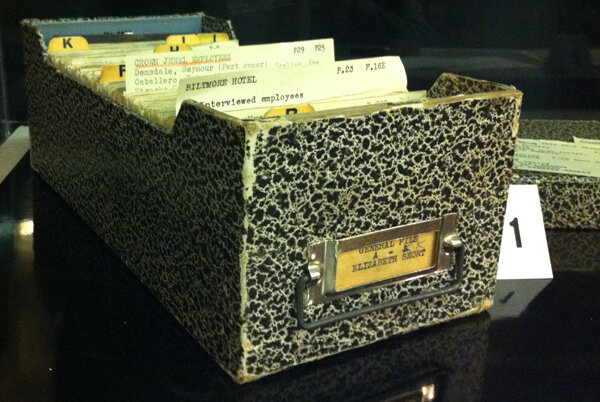
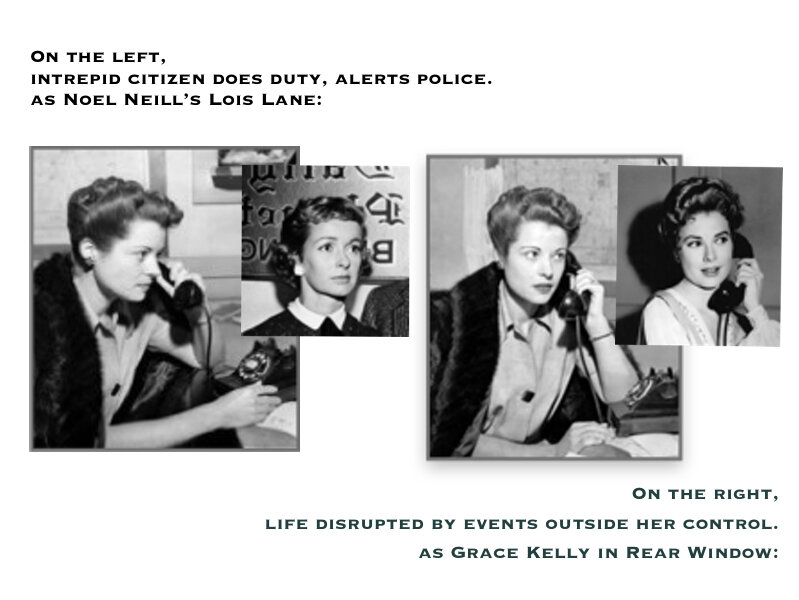

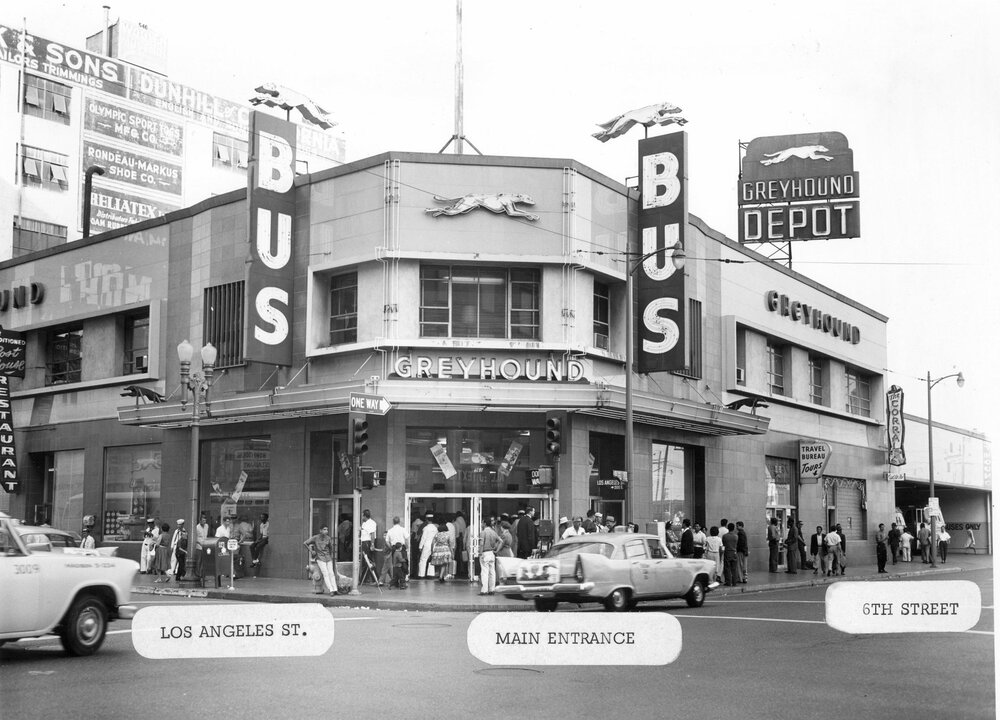
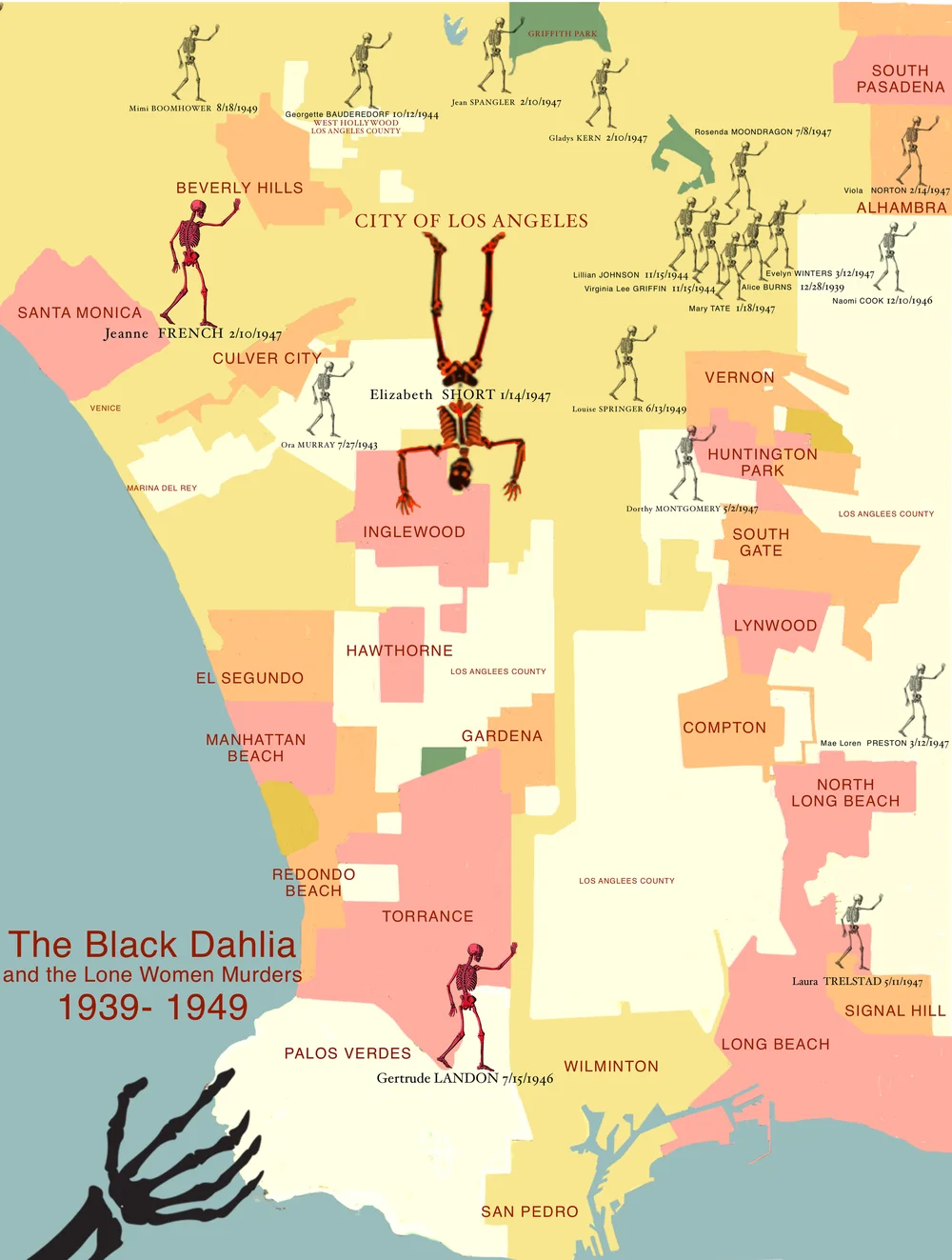
12 ตอน




